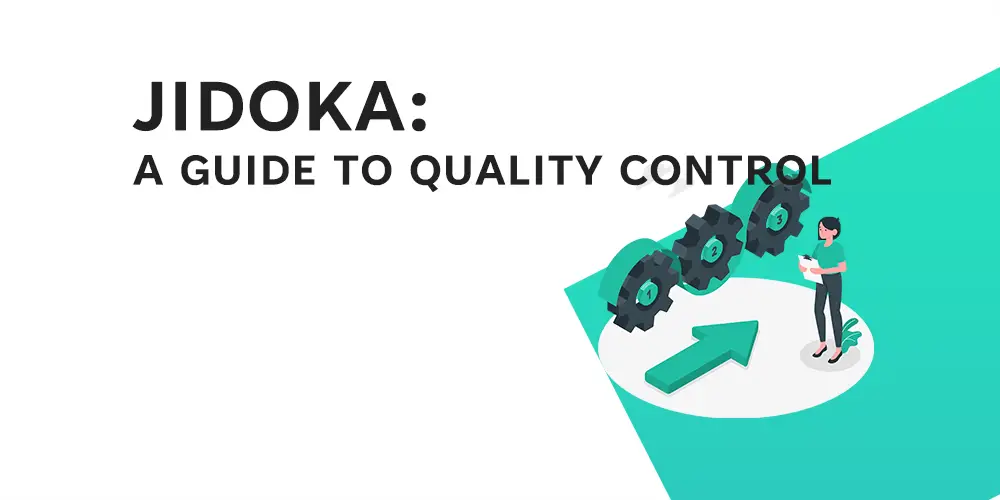Quality control is an important part of any manufacturing process because it ensures that products meet specific standards and specifications. Jidoka, a Japanese term that translates to “automation with a human touch,” is one approach to quality control that has gained traction in recent years. Jidoka is a key concept in the Toyota Production System, where it is used to boost efficiency and prevent defects.
In this blog post, we’ll go over Jidoka in greater detail, explaining what it is, how it works, and why it’s so important in quality control. This guide will provide a comprehensive overview of Jidoka and its role in improving quality control, whether you are a manufacturing professional or simply interested in learning about this innovative approach to automation.
What is Jidoka
Jidoka is a manufacturing concept that seeks to improve quality control by incorporating human intelligence into automated processes. “Jidoka” is a combination of two Japanese words: “jidou” (automation) and “kaizen” (meaning improvement). Jidoka is an important part of the Toyota Production System, which is known for emphasizing lean manufacturing, continuous improvement, and waste reduction.
Jidoka is fundamentally about incorporating quality into the manufacturing process rather than relying on inspection and rework to correct defects. Jidoka frees workers up to focus on higher-level tasks like problem-solving and process improvement by automating repetitive tasks and using machines to monitor production.
The Two Key Components of Jidoka
Jidoka has two main components: autonomy and stop-and-fix. Autonomy refers to the use of machines to automate repetitive tasks, whereas stop-and-fix refers to machines’ ability to detect defects and halt production to prevent further defects from being created.
Machines are used in the case of autonomation to perform tasks that are repetitive or require a high degree of accuracy. A machine, for example, could be used to drill holes in a metal sheet, eliminating the need for workers to perform this task manually. Workers can focus on more complex and creative tasks that require their skills and expertise by automating these types of tasks.
There are two key components of Jidoka: autonomation and stop-and-fix. Autonomation refers to the use of machines to automate repetitive tasks, while stop-and-fix refers to the ability of machines to detect defects and stop production to prevent further defects from being created.
In the case of autonomation, machines are used to perform tasks that are repetitive or require a high degree of accuracy. For example, a machine may be used to drill holes in a metal sheet, reducing the need for workers to perform this task manually. By automating these types of tasks, workers can focus on more complex and creative tasks that require their skills and expertise.
Autonomy and stop-and-fix are powerful tools for improving quality control in manufacturing when used together. Jidoka helps to build quality into the manufacturing process by integrating human intelligence with automated processes, rather than relying on inspection and rework to correct defects. This method not only improves product quality, but also reduces waste, increases efficiency, and, ultimately, leads to higher customer satisfaction.
The Benefits of Jidoka in Quality Control
Jidoka is a powerful tool for improving manufacturing quality control, with numerous advantages that can help to improve product quality, reduce waste, and increase efficiency.
One of Jidoka’s primary advantages is its ability to detect and prevent manufacturing defects. Jidoka enables defects to be detected early, before they can be passed on to downstream processes, by using machines to monitor production and detect abnormalities. Early defect detection and prevention can save time and money by reducing the need for rework or inspections later on. It can also improve product quality by detecting flaws before they reach the final product, lowering the likelihood of customer complaints or returns.
Jidoka can also boost efficiency and productivity by lowering waste and improving process stability. Jidoka frees workers to focus on higher-level tasks like problem-solving and process improvement by automating repetitive tasks and using machines to monitor production. This can lead to increased productivity because workers can use their skills and expertise to improve processes and identify waste-reduction opportunities.
Jidoka can also increase efficiency by reducing the number of inspections and rework required. Jidoka reduces the likelihood of defects being passed on to downstream processes by detecting them early in the process, which can save time and money. This method also reduces the need for inspections and rework because defects are detected and corrected before they become larger issues.
Implementing Jidoka in Manufacturing
Implementing Jidoka in a manufacturing setting necessitates a methodical approach that includes identifying areas for improvement, designing machines and processes that adhere to Jidoka principles, and training workers on how to use Jidoka tools and techniques.
The first step in putting Jidoka into action is to identify areas for improvement in the manufacturing process. This may entail conducting a thorough analysis of current processes, identifying areas where defects are most likely to occur, but using tools such as FMEA analysis which you can conduct using our FMEA Template and developing a strategy for using Jidoka to improve those processes.
After identifying areas for improvement, the next step is to design machines and processes that adhere to Jidoka principles. This may entail redesigning existing machines or creating new machines capable of performing tasks more efficiently and accurately a process often used for this process is called DFSS (Design for Six Sigma). It may also entail developing new processes to detect and prevent defects, such as visual inspections or automated sensors.
It is critical to train workers on how to use Jidoka tools and techniques in addition to designing machines and processes. This could include teaching employees how to operate machines, detect and repair defects, and use visual management techniques to improve processes.
Visual management is an essential component of Jidoka because it allows workers to easily identify abnormalities and take corrective action. Visual signals, such as coloured lights or flags, can be used to indicate when a machine is in trouble or when a defect has been detected. It may also entail developing visual displays, such as graphs or charts, to demonstrate the performance of machines and processes over time.
One of the primary advantages of visual management in Jidoka is that it allows workers to quickly identify anomalies and take corrective action. This can help to reduce the time and cost of detecting and correcting defects while also improving overall process efficiency and productivity.
Jidoka vs Automation
Jidoka and automation are both important tools for improving manufacturing processes, but they differ in several key ways.
Traditional automation typically entails using machines to perform repetitive tasks, such as assembly or packaging, with little or no human intervention. This method can boost efficiency and productivity by reducing the time and cost associated with manual labour. Traditional automation, on the other hand, may not be well-suited for detecting and preventing defects in the manufacturing process.
Jidoka, on the other hand, is intended to address this problem by combining automation and human intelligence. Jidoka entails using machines to monitor production and detect anomalies, but it also entails giving workers the authority to halt production if a defect is discovered. This method helps to ensure that defects are identified early and addressed before they cause downstream issues.
Another significant distinction between Jidoka and traditional automation is the degree of customization and flexibility that each approach provides. Traditional automation typically involves the use of machines that are purpose-built for a specific task and may be difficult to modify or adapt to new processes. Jidoka, on the other hand, is built to be highly adaptable and flexible, allowing workers to easily modify machines and processes in response to new challenges or opportunities.
Finally, Jidoka is distinct from other forms of automation in that it focuses on improving manufacturing process quality rather than simply increasing productivity. While traditional automation may be concerned with lowering labour costs and increasing output, Jidoka is intended to improve product quality and reduce waste by detecting and preventing defects.
Examples of Jidoka in Action
Jidoka has been successfully implemented in a variety of industries worldwide.
Jidoka has been used in the automotive industry, where companies such as Toyota and Honda have adopted it. Jidoka is used in Toyota’s manufacturing plants to detect and prevent defects in the manufacturing process, ensuring that only high-quality products are produced. As a result, costs have been reduced and customer satisfaction has increased, as customers are receiving products that meet their expectations.
Jidoka is also being used in the food industry, where companies such as Nestle and Mars have adopted it. Jidoka is used in these companies to detect and prevent quality issues in food production, such as foreign objects or contamination. This has resulted in improved product quality and safety, as well as lower costs associated with product recalls or waste.
Jidoka has also been used in the healthcare industry, where hospitals and healthcare providers have adopted it to improve patient safety and reduce medical errors. Jidoka, for example, can be used to detect and prevent medication errors, such as administering the incorrect dose or medication. As a result, patient outcomes have improved and costs associated with medical errors have been reduced.
The advantages of using Jidoka vary depending on the industry and the specific implementation. However, some common benefits include better quality control, lower costs for defects and waste, and increased efficiency and productivity. Jidoka can also boost employee morale and job satisfaction by empowering workers to detect and address quality issues rather than simply performing repetitive tasks.
Conclusion
To summarise, Jidoka is a powerful quality control approach that has been successfully implemented in a variety of industries around the world. Jidoka can improve product quality, reduce costs, and increase efficiency and productivity by focusing on detecting and preventing defects in the manufacturing or production process. It entails using autonomy, visual management techniques, and a high level of human involvement in the process.
Jidoka isn’t just for manufacturing or production; it can also be used in other industries like healthcare to improve patient safety and reduce medical errors. Companies and organisations can achieve a culture of continuous improvement by implementing Jidoka, in which employees are empowered to detect and address quality issues, as well as collaborate to improve the overall process.
In conclusion, Jidoka is a powerful tool that can assist businesses and organisations in improving their products or services, lowering costs, and increasing efficiency and productivity. Businesses can gain a competitive advantage and deliver high-quality products or services that meet or exceed customer expectations by taking this approach.








